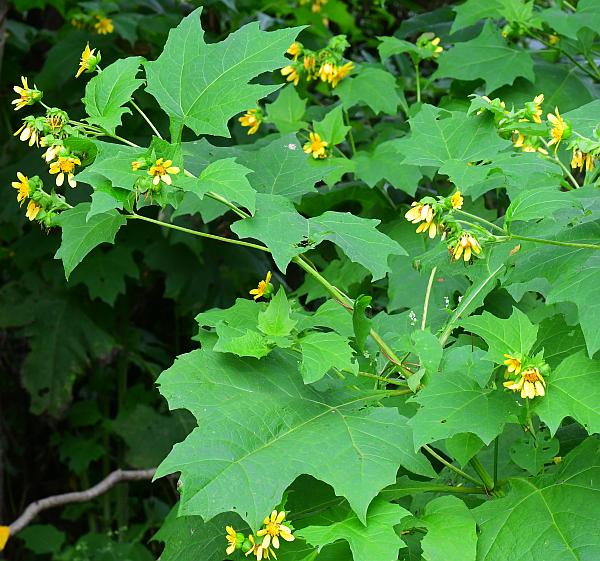Smallanthus uvedalia (L.) Mack.
Bearsfoot

Native
CC = 8
CW = 5
MOC = 35
© SRTurner
Smallanthus uvedalia (L.) Mack.Bearsfoot | |
 |
Native CC = 8 CW = 5 MOC = 35 |
© SRTurner |
|
Family - Asteraceae/Heliantheae Habit - Perennial forb, with fibrous or sometimes somewhat tuberous roots. Stems - Ascending, to 1.5 m, usually branched, with fine longitudinal lines or ridges, moderately to densely pubescent with spreading, nonglandular and/or gland-tipped hairs toward the tip, often glabrous or nearly so toward the base.
Leaves - Opposite or the uppermost few alternate, sessile or short-petiolate below the tapered, winglike blade base, the bases slightly expanded and wrapping around the stem. Leaf blades 3-35 cm long, ovate to broadly ovate or broadly obovate, more or less palmately 3-or 5-lobed, tapered at the base, the main lobes sharply pointed at the tip, the margins coarsely and irregularly few-toothed or shallowly few-lobed and hairy, the upper surface sparsely to moderately roughened-pubescent with slender, stiff, somewhat curved hairs, the undersurface with moderate to dense, short, somewhat spreading hairs, especially along the veins, also with sessile, spherical, yellow glands.
Inflorescences - Relatively open, irregular clusters of heads at the branch tips, subtended by leaflike bracts mostly in pairs at the branch points, the heads mostly with relatively short, hairy and/or glandular stalks. Heads - Radiate. Involucre 10-20 mm long, 8-15 mm in diameter, cup-shaped, the bracts in 1 series. Involucral bracts 4-6, loosely ascending, slightly longer than the outermost chaffy bracts, broadly lanceolate to more commonly elliptic or broadly ovate, rounded or narrowed to an abrupt, minute, blunt or sharp point at the tip, green and somewhat leaflike, the margins with spreading hairs, the outer surface glabrous or sparsely to moderately pubescent with short, fine hairs, often also sparsely to moderately glandular. Receptacle flat or slightly convex, not elongating as the fruits mature, with chaffy bracts subtending the ray and disc florets, those subtending the ray florets slightly longer than the others, 6-14 mm long, lanceolate to ovate, thin and papery but usually with a greenish-tinged apical portion, concave and wrapped around the florets.
Florets - Ray florets 7-13, pistillate with a 2-branched style exserted from the short tube at flowering, the corolla 12-25 mm long, relatively broad and often slightly cupped, yellow, the short, tubular base moderately short-hairy and/or glandular, the outer surface of the ligule often minutely glandular, withered at fruiting. Disc florets 45-80, staminate (with a small, stalklike ovary and a more or less undivided style), the corolla 7-10 mm long, yellow, sparsely glandular or hairy, not expanded at the base. Style branches with the sterile tip somewhat elongate and tapered. Pappus absent.
Fruits - Achenes 5.5-6.5 mm long, elliptic-obovate in outline, dark brown to nearly black when mature, glabrous, somewhat glossy. Pappus absent. Since only the ray florets are fertile, achenes are present in a ring around the perimeter of the head.
Flowering - July - September. Habitat - Forest understory and openings, ravines, bluffs, streambanks, pastures. Origin - Native to the U.S. Lookalikes - Polymnia canadensis. Other info. - This showy species occurs in scattered locations in Missouri, predominantly in the southern half of the state. Its distribution within the continental U.S. includes about the southeastern third of the country. It is not a particularly common plant. Though having a relatively high coefficient of conservatism, it can sometimes be found in disturbed areas alongside well-traveled trails. It is easily identified by the large, maple-like leaves and the flowering heads which have a unique appearance. The ray florets are relatively few in number and typically well-separated. Because the rays are the fertile elements of the heads, the fruits which develop form a conspicuous ring around the perimeter of the head. These achenes are different from those of most other plants in the family, being relatively large and globose, and lacking a fluffy pappus. Their appearance suggests good pea-shooter ammo. Photographs taken in the Ozark Scenic Riverways, 8-17-03 (DETenaglia); also in Weldon Spring, 9-26-2008 and 8-15-2010, along the Katy Trail near Dutzow, MO, 9-4-2015, and along Fox Creek, St. Louis County, MO, 9-2-2020 (SRTurner). |